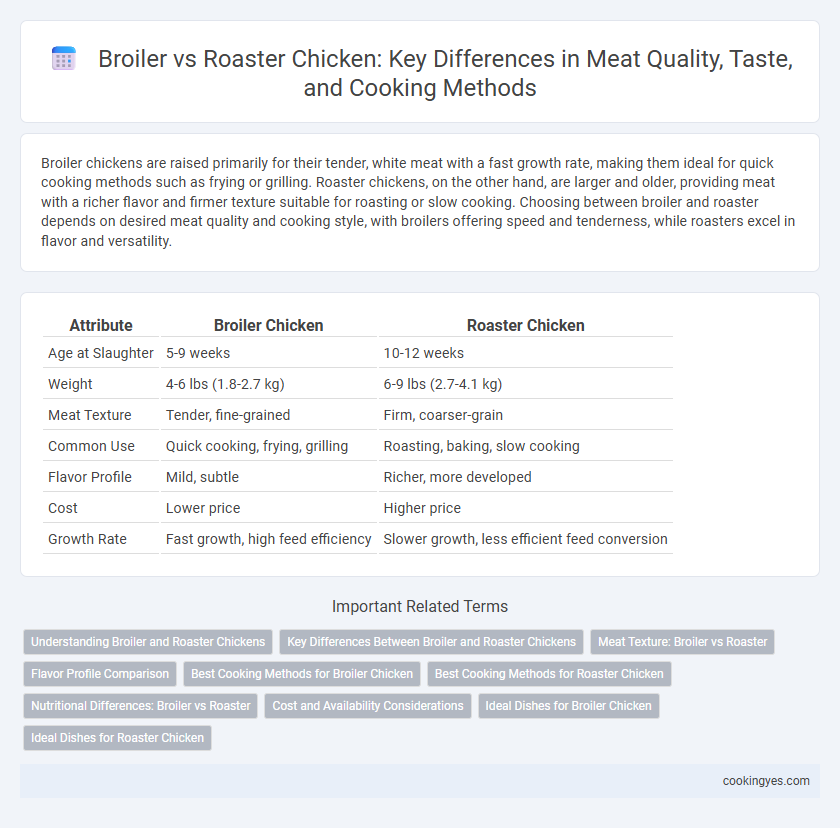Broiler chickens are raised primarily for their tender, white meat with a fast growth rate, making them ideal for quick cooking methods such as frying or grilling. Roaster chickens, on the other hand, are larger and older, providing meat with a richer flavor and firmer texture suitable for roasting or slow cooking. Choosing between broiler and roaster depends on desired meat quality and cooking style, with broilers offering speed and tenderness, while roasters excel in flavor and versatility.
Table of Comparison
| Attribute | Broiler Chicken | Roaster Chicken |
|---|---|---|
| Age at Slaughter | 5-9 weeks | 10-12 weeks |
| Weight | 4-6 lbs (1.8-2.7 kg) | 6-9 lbs (2.7-4.1 kg) |
| Meat Texture | Tender, fine-grained | Firm, coarser-grain |
| Common Use | Quick cooking, frying, grilling | Roasting, baking, slow cooking |
| Flavor Profile | Mild, subtle | Richer, more developed |
| Cost | Lower price | Higher price |
| Growth Rate | Fast growth, high feed efficiency | Slower growth, less efficient feed conversion |
Understanding Broiler and Roaster Chickens
Broiler chickens are specifically bred for rapid growth, reaching market weight of 4 to 6 pounds within 6 to 8 weeks, making them ideal for tender and juicy meat commonly used in everyday meals. Roaster chickens are older, typically 8 to 12 weeks old, weighing between 6 to 8 pounds, offering firmer meat with a slightly stronger flavor, suitable for slow roasting and hearty dishes. Differences in age, weight, and breed influence texture, flavor, and cooking methods, making broilers preferable for quick-cooking recipes and roasters better for slow-cooked meals.
Key Differences Between Broiler and Roaster Chickens
Broiler chickens are bred for rapid growth and typically reach slaughter weight between 6 to 8 weeks, producing tender and mild-flavored meat ideal for frying and grilling. Roaster chickens are older, usually 8 to 12 weeks old, with larger size and firmer texture, making them suitable for roasting and slow cooking methods. The key differences lie in age, weight, texture, and cooking applications, with broilers offering quick-cooking tenderness and roasters providing more developed flavor and meat density.
Meat Texture: Broiler vs Roaster
Broiler chicken meat features a tender texture with a higher moisture content, making it ideal for quick cooking methods such as grilling and frying. Roaster chicken meat possesses a firmer, denser texture due to its older age at slaughter, which enhances flavor development and suitability for roasting or slow-cooking. Differences in muscle fiber composition and collagen content between broilers and roasters significantly influence the final meat texture and culinary applications.
Flavor Profile Comparison
Broiler chickens, typically slaughtered at 6 to 8 weeks old, have a tender texture with a mild, delicate flavor ideal for quick cooking methods. Roaster chickens, aged around 8 to 12 weeks, develop a richer, more robust taste and firmer meat suited for slow roasting. The higher fat content in roasters enhances juiciness and depth of flavor compared to the lighter broiler meat.
Best Cooking Methods for Broiler Chicken
Broiler chickens, typically harvested at 6 to 8 weeks old, have tender meat ideal for quick cooking methods like grilling, frying, and roasting at high temperatures. Their relatively high fat content ensures juicy results when using techniques such as pan-searing or deep-frying, which preserve moisture and enhance flavor. Unlike roasters, broilers require shorter cooking times to prevent dryness, making them perfect for dishes like grilled chicken breasts, stir-fries, and crispy fried chicken.
Best Cooking Methods for Roaster Chicken
Roaster chickens, being older and larger than broilers, benefit from slow roasting or braising to tenderize their firmer meat, ensuring rich, succulent flavors. Methods like oven roasting at low temperatures or cooking in a covered pot retain moisture and enhance juiciness. These techniques contrast with broilers, which suit quick grilling or frying due to their tender texture and smaller size.
Nutritional Differences: Broiler vs Roaster
Broiler chicken meat typically contains lower fat content and higher protein levels compared to roaster chicken, making it a leaner choice suitable for health-conscious diets. Roaster chickens, being older and larger, often provide richer flavor and slightly higher fat and calorie content, contributing to a more tender texture. The differences in nutritional profile influence cooking methods and consumer preferences, with broilers favored for quick meals and roasters for slow-cooked recipes.
Cost and Availability Considerations
Broiler chickens, raised for 6 to 8 weeks, offer a cost-effective option due to their rapid growth and widespread availability in supermarkets and poultry markets. Roaster chickens, typically 8 to 12 weeks old, have higher feed and maintenance costs, making them pricier but favored for larger, tender cuts. Availability of broilers is consistent year-round, while roasters may be seasonal or less common, influencing pricing and procurement decisions.
Ideal Dishes for Broiler Chicken
Broiler chickens, typically slaughtered at 6 to 8 weeks old, have tender, juicy meat ideal for quick-cooking methods like frying, grilling, or sauteing. Their mild flavor and soft texture make them perfect for dishes such as fried chicken, chicken stir-fry, and grilled chicken breasts. The lean meat of broilers readily absorbs marinades and seasonings, enhancing taste and suitability for diverse recipes.
Ideal Dishes for Roaster Chicken
Roaster chicken, known for its larger size and tender, flavorful meat, is ideal for dishes that require slow roasting or braising, such as herb-stuffed roast chicken or braised chicken with root vegetables. Its higher fat content compared to broilers enhances moisture retention and enriches the taste in recipes like classic coq au vin or hearty chicken pot pie. The meat's texture holds up well in dishes demanding prolonged cooking, making it a preferred choice for festive meals and slow-cooked preparations.
Broiler vs Roaster for chicken meat Infographic

 cookingyes.com
cookingyes.com